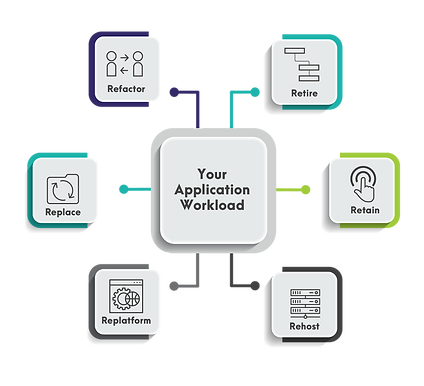
Getting the most out of your Cloud Investment
Getting your organisation to cloud is only the first part of the journey. Once you are hosting workloads in the cloud, you need to capitalise on the efficiency and innovation potential it offers.
We offer cloud application modernisation services to help you transform your current application portfolio to a modern cloud environment. Partnering with your development and architecture teams, we can address configuration and architecture challenges. The focus is on:
-
A cloud-first development strategy
-
Cloud integration tools and automation
![Cloud object_Turquoise cloud[50].png](https://static.wixstatic.com/media/59be80_9894eeca46a949419a05f5d637bd3f20~mv2.png/v1/fill/w_279,h_280,al_c,q_85,usm_0.66_1.00_0.01,enc_avif,quality_auto/Cloud%20object_Turquoise%20cloud%5B50%5D.png)
Cloud Modernisation
Modernise your Applications
Cloud modernisation is all about an opportunity to optimise your business applications. Note that applications that are not designed to take full advantage of cloud computing will never realise their maximum value to your business.
Only cloud native applications – built on the cloud, for the cloud – provide optimal efficiencies. Cloud native applications are agile and resilient, sense and respond to market shifts. This will enable continual improvement and will provide a seamless experience for customers and stakeholders.
Modernise your Infrastructure
For most companies, digital transformation will require modernisation of their data center infrastructure. The goal is to adopt a hardware and software technology stack that works across private data centers, hybrid cloud and edge facilities.
Modernise your Data
Digital transformation is not just about technology, it is about business processes. Aligning those processes to your goals - such as delivering new products and services faster and superior customer experiences - is foundational to leading in this everything-as-a-service era.
It also means getting the right data to the right applications at the right business moment. Optimising applications means fitting the infrastructure to what the application needs, not the other way around. Similarly, deploying your applications and data sources to the right cloud service enables better agility, performance and economics.
The 6 R's: A Winning Formula
Migration to the cloud is important for companies looking to achieve digital transformation and explore growth opportunities. The 6 R’s are your essential methodology to structure and communicate your application transformation roadmap. The 6R's framework allows the formulation of decisions on how each application in the journey to the cloud can be optimised.
1. Rehost
Also known as ‘Lift and Shift’, rehosting is often considered one of the easiest ways to migrate an existing workload to the cloud as it involves taking the workload on an as-is basis and hosting it in the cloud. The aim of Lift & shift is to provision, workload and infrastructure resources to match existing, on-premises architecture without modification.

2. Replatform
Also known as ‘Lift, Tinker and Shift’. This approach means making some cloud optimisations to achieve some tangible benefit without changing the core architecture of the application. While the applications are going to stay generally the same, some thought is put into how the cloud is going to be able to improve upon their use.
Also known as Re-architecting. Refactoring is typically the most expensive option as it involved re-architecting your existing environment to to achieve your new business. This approach is commonly used by applications that need thorough modernisation due to outdatedness or performance issues. Typically this involves breaking down the application’s components into smaller building blocks, microservices and wrapping them into containers for a deployment on a container platform or exploiting a serverless architecture.
4. Replace (Repurchase)
Also known as Repurchase is the strategy where the legacy application is fully replaced by a SaaS-solution that provides the same or similar capabilities. The migration effort depends on the requirements and options of migrating (live) data. Some SaaS-replacements for on-premise products from the same vendor offer an option to quickly migrate data with little effort or even automatically. Other providers offer analysis tools to assess and determine the best migration effort.
5. Retire
The Retire strategy means that an application is explicitly phased out. This is all about knowing which assets are no longer required so that they can be switched off to saves time and money in the long term. However, identifying which ones to ‘turn off’ requires careful consideration and planning to prevent any unknown issues from arising. This is common in those cases where organisations recently went through mergers and acquisitions.
6. Retain (Remain)
This can be seen as the “do nothing” approach but, it is really a revisit as the do nothing is a holding state. Maybe the application will be deprecated soon or was recently purchased or even upgraded and so is not a priority for further investment. It is likely to be addressed by one of the other approaches at some point in future.
